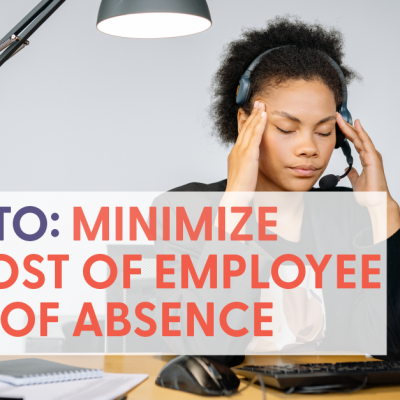Cost (n.); an amount that has to be paid or spent to buy or obtain something.
When thinking about the idea of “cost” as a business, as defined above, it’s important to note that “an amount” is not specifically referencing money. Money, time and emotional energy are all things “spent” while operating an enterprise of any size, and there’s perhaps no better example of this than factoring in the costs surrounding an employee leave of absence.
While most employees have the right to take a leave of absence from work for a variety of reasons, many companies don’t look into the actual cost to effectively facilitate a leave, in part because the majority aren’t given the resources to effectively facilitate a leave in the first place.
Some costs associated with an employee leave of absence are fixed, namely, the productivity lost due to that employee taking leave, however, there are many elements to a leave of absence that should be considered when evaluating how to minimize their cost on your organization.
Time is Money…and Other Obvious Phrases
Sometimes the most frequently recited anecdotes get collectively glossed over as either folk wisdom or considered something so obvious we deem them unworthy to pay them much attention. In the business world we know that time is money, but how often do we treat the time we spend with the same level of scrutiny as the dollars we spend?
Our research shows that managing a leave can take an HR manager anywhere from 20-40 hours depending on complexity. Our numbers also show that you can expect roughly 10% of your workforce to need a leave of absence in a given year. Therefore a company of 250 can expect to allocate roughly 500 workforce hours a year just to manage leave.
The time is spent on:
- Researching updated leave laws for a given state (more on this later)
- Organizing, preparing and facilitating benefit forms for their employees to fill out and submit
- Communicating with and educating managers
- Working with payroll to calculate how much an employee is getting paid, and by who, and for how long.
- Tracking each leave as they progress in numerous excel tabs progresses.
That is a ton of administrative work for anyone to handle, and it’s only a fraction of an HR manager’s responsibility. In fact, we frequently hear from our customers that managing leave is “10% of my job, and 90% of my headaches.”
Eliminating the administrative burdens on People Teams by providing resources that streamline their processes is a surefire way to reduce the number of hours spent managing leave, and increase the hours spent on impactful work for the people running your organization.
Reliance on Compliance
Circling back to bullet point #1 as promised, the time (and money) spent on researching leave laws can’t be overstated. For one, they’re constantly changing and oftentimes confusing as heck to parse out, secondly, they can have big financial ramifications if it turns out you aren’t operating in a compliant manner.
One of the biggest risks to organizational compliance comes from managers, who are one of the leading causes of employment violations. So not only do People Teams need to make sure they’re operating under both Federal and State guidelines as it pertains to leave, they also need to make sure the manager of the employee taking leave knows the law about what they can and can’t do or say.
The average cost to defend one FMLA lawsuit? $80,000. As an example, if an employee wins their lawsuit against you claiming that they were wrongfully terminated, that can cost an organization between $87,500 and $450,000.
Keeping up with compliance mandates can be time-consuming, but the cost of not keeping up can be crippling.
Don’t Miss Out on Free Money
State programs like State Disability Insurance (SDI) in California and Paid Family Leave (PFL) in 11 states (plus D.C.) and counting, help organizations offset the salary costs of an employee going on leave by providing pay assistance, though many organizations don’t have the bandwidth to stay up to date on the latest program offerings and help their people apply or are unaware they can be applied for in the first place.
This opportunity gets missed even more now that employees are working in states that they may have not previously resided in and therefore People Teams might not know all that there is to offer.
The juice of applying for these benefits is almost always worth the squeeze, however, as it can save your organization thousands of dollars in employee salary that can be covered by the government. In California, for example, a company would save $10,856 for a typical non-birthing leave.
Pounce on these programs and free up funds for literally anything else.
Avoid the Point of No Return
Another cost that must be factored into all leave of absence management programs is replacing talent. When an employee’s future is left uncertain, they leave — and never come back. And when a leave of absence is handled poorly or if they don’t feel supported, it increases the likelihood of them leaving even more.
Losing institutional knowledge, productivity and important threads of your cultural fabric is not only detrimental to an organization’s productivity, but also to the time, effort and money it will take to replace that talent.
It’s reported that it costs anywhere from 50% to 200% of an employee’s salary to replace them. Ensuring the employee feels supported as they take their leave dramatically increases the likelihood of them reboarding thus saving both money and keeping morale high. This is why retention is the #1 priority for HR departments heading into 2023.
Make the Changes Today
Minimizing the costs of employee leave of absence isn’t always straightforward. Lean People teams and dispersed workforces make the challenges of alleviating administrative burden, staying compliant, applying for free money and creating a positive leave experience for your employees very difficult.
About Tilt
Tilt is leading the charge in all things leave of absence management through easy-to-use tech and human touch. Since 2017, our proprietary platform and Empathy Warriors have been helping customers make leave not suck by eliminating administrative burdens, keeping companies compliant, and providing a truly positive and supportive leave of absence experience for their people.







